bulb OPEL GT-R 1973 Service Manual
[x] Cancel search | Manufacturer: OPEL, Model Year: 1973, Model line: GT-R, Model: OPEL GT-R 1973Pages: 625, PDF Size: 17.22 MB
Page 29 of 625
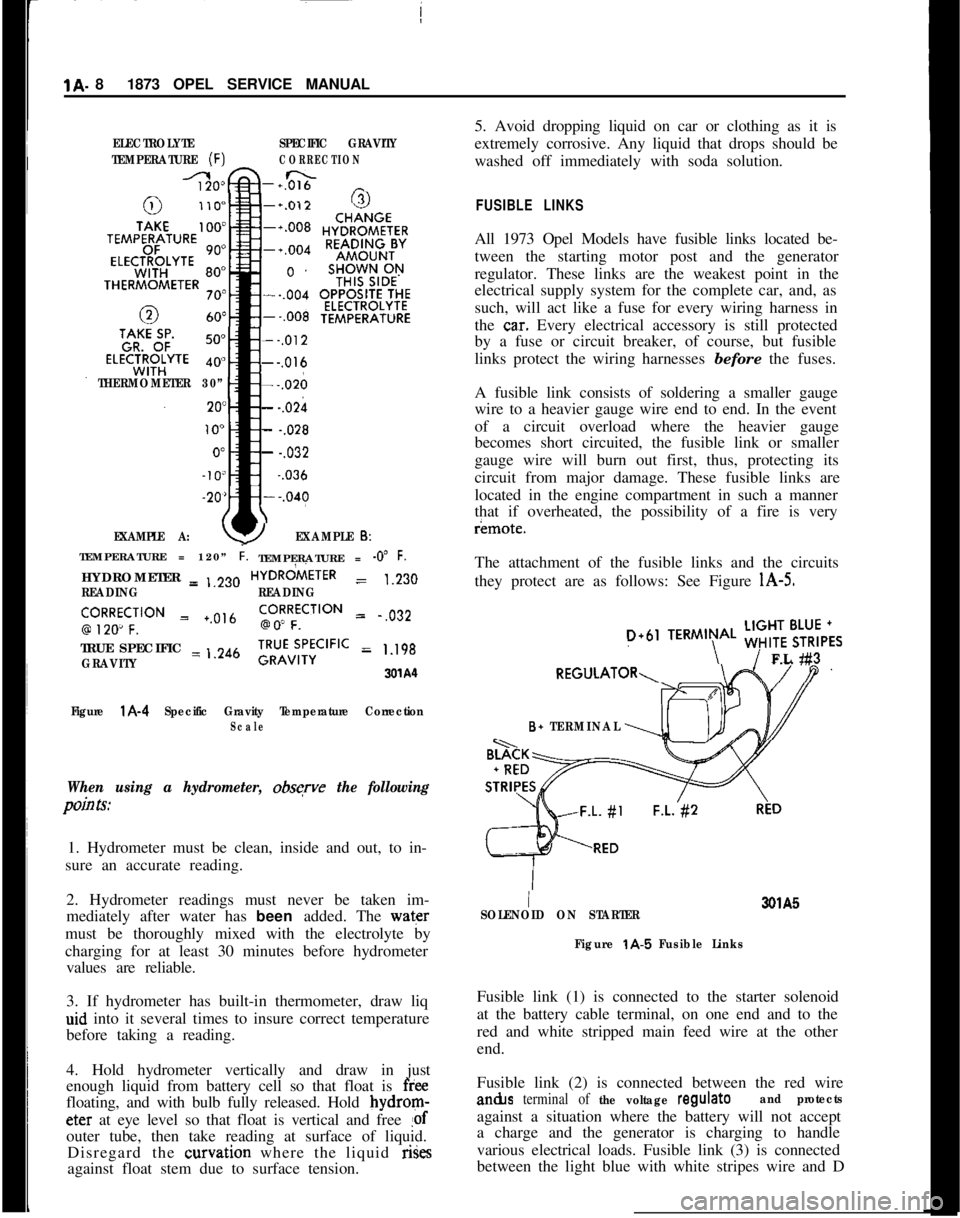
1A. 81873 OPEL SERVICE MANUALELECTROLYTESPECIFIC GRAVITY
TEMPERATURE
(F)CORRECTION
-+0&&n _
THERMOMETER 30”
EXAMPLE A:
--,012---,016---,026
- -.02h
- -.028
- -.032~
-.036
YEXAMPLE 6:TEMPERATURE = 120”
i.TEMPERATURE = -0” F.HYDROMETER = ,,230HYDRdiETER
= 1.230
READINGREADING
‘,9R2Ro~CF;‘“” = +.0,6go!RFfCilON = .,032
TRUE SPECIFIC = ,.246
GRAVITY;RU”v;,‘;CIFIC = 1.198
3xA‘l
Figure
l A-4 Specific Gravity Temperature CorrectionScale
When using a hydrometer, obsqve the following
pain Is:1. Hydrometer must be clean, inside and out, to in-
sure an accurate reading.
2. Hydrometer readings must never be taken im-
mediately after water has been added. The water
must be thoroughly mixed with the electrolyte by
charging for at least 30 minutes before hydrometer
values are reliable.
3. If hydrometer has built-in thermometer, draw liq
aid into it several times to insure correct temperature
before taking a reading.
4. Hold hydrometer vertically and draw in just
enough liquid from battery cell so that float is
freefloating, and with bulb fully released. Hold bydrom-eter at eye level so that float is vertical and free
!ofouter tube, then take reading at surface of liquid.
Disregard the curvation where the liquid rises
against float stem due to surface tension.5. Avoid dropping liquid on car or clothing as it is
extremely corrosive. Any liquid that drops should be
washed off immediately with soda solution.
FUSIBLE LINKSAll 1973 Opel Models have fusible links located be-
tween the starting motor post and the generator
regulator. These links are the weakest point in the
electrical supply system for the complete car, and, as
such, will act like a fuse for every wiring harness in
the
ca.r. Every electrical accessory is still protected
by a fuse or circuit breaker, of course, but fusible
links protect the wiring harnesses before the fuses.
A fusible link consists of soldering a smaller gauge
wire to a heavier gauge wire end to end. In the event
of a circuit overload where the heavier gauge
becomes short circuited, the fusible link or smaller
gauge wire will burn out first, thus, protecting its
circuit from major damage. These fusible links are
located in the engine compartment in such a manner
that if overheated, the possibility of a fire is veryr¬e.
The attachment of the fusible links and the circuits
they protect are as follows: See Figure
l A-5.
D+61TERMIN\AL ;;!$6,,FL #3
B+ TERMINAL
I3QlA5
SOLENOID ON STARTER
Figure
t A-5 Fusible LinksFusible link (1) is connected to the starter solenoid
at the battery cable terminal, on one end and to the
red and white stripped main feed wire at the other
end.
Fusible link (2) is connected between the red wirean&s
terminal of the voltage regulateand protectsagainst a situation where the battery will not accept
a charge and the generator is charging to handle
various electrical loads. Fusible link (3) is connected
between the light blue with white stripes wire and D
Page 70 of 625

LIGHTING SYSTEMSlF-492. Take
Le:s off housing. See Figure lF-7.
3. Remove housing.1
Installation;I
1. Install
le$ in housing.
2. Replace
+.Model 54
;,
1, Remove Ilamp lens from outside.
/
2. Remove kear quarter trim pad.
/
3. Remove
ifour screws from inside car. See FigurelF- 8.
Figure 1 F-8
I- Removing Tail Light Housing - Model 54
I
4. Disconnkct wiring connector.
I
1. Connect iwiring to lamp
2. Install hbusing using four (4)
scre%s.3. Replace
p quarter trim pad
4. Replace
Lens,Models
57-$RI
Removal1. Unscrew!lens from housing.2.
III luggage compartment, unscrew three (3) hous-
ing attaching nuts. See Figure lF-9.
Figure lF-9 Tail Light Housing Attaching Nuts
-Models 57.57R
3. Disconnect wire connector.
Installation1. Plug in wiring harness.
2. Replace housing with three (3) attaching nuts.
3. Replace lens.
Rear License Plate Lamp Assembly Removal1. Remove two screws holding housing to bumper.
2. Pull lamp assembly down.
3. To replace bulb, take out two
screws holding lens
in place.
Installation1. Replace bulb and lens to housing.
2. Replace lamp assembly to bumper with two (2)
screws.
SIDE MARKER LIGHTS
Front Removal1. Remove outer lens.
2. Remove two sheet metal screws for housing at-
tachment.
3. Disconnect wire connectors.
Page 76 of 625
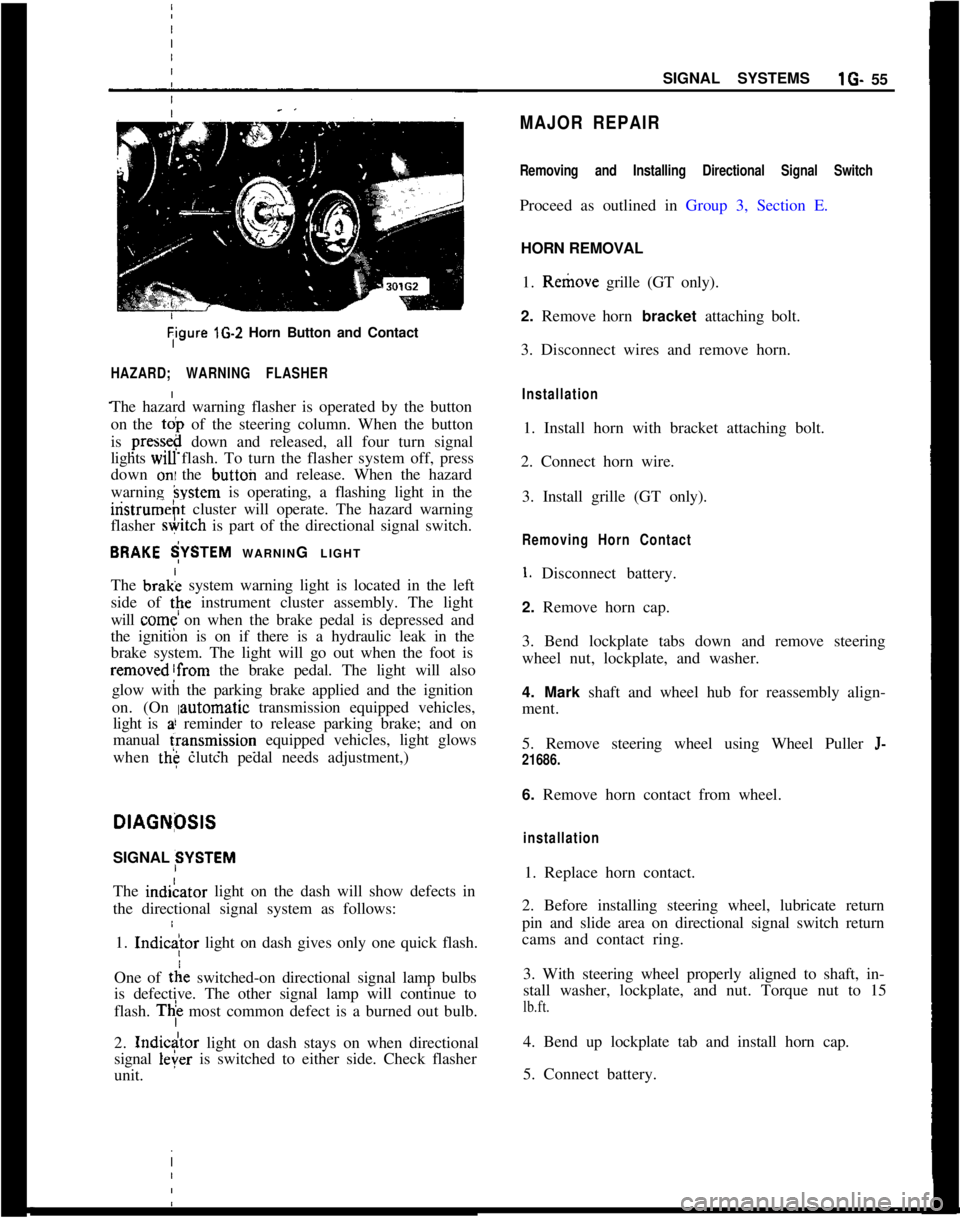
Tigure lG-2 Horn Button and Contact
HAZARD; WARNING FLASHER
The hazard warning flasher is operated by the button
on the
toi, of the steering column. When the button
is
press&@ down and released, all four turn signal
lights
WIU flash. To turn the flasher system off, press
down
oni the button and release. When the hazard
warning
hystem is operating, a flashing light in the
iristrumeht cluster will operate. The hazard warning
flasher
&itch is part of the directional signal switch.
BRAKE $YSTEM WARNING LIGHT
The brak; system warning light is located in the left
side of
tpe instrument cluster assembly. The light
will
come on when the brake pedal is depressed and
the ignition is on if there is a hydraulic leak in the
brake system. The light will go out when the foot is
removed!from the brake pedal. The light will also
glow with the parking brake applied and the ignition
on. (On
Iautomatic transmission equipped vehicles,
light is
a! reminder to release parking brake; and on
manual
fransmission equipped vehicles, light glows
when
the clutch pedal needs adjustment,)
I
DlAGNfXlS
SIGNAL SYSTEM
The indiLator light on the dash will show defects in
the directional signal system as follows:
1.
Indic
tie switched-on directional signal lamp bulbs
is defective. The other signal lamp will continue to
flash.
Thi most common defect is a burned out bulb.
2.
Indicdtor light on dash stays on when directional
signal
leier is switched to either side. Check flasher
unit. I
SIGNAL SYSTEMSlG- 55
MAJOR REPAIR
Removing and Installing Directional Signal Switch
Proceed as outlined in Group 3, Section E.
HORN REMOVAL
1. Remove grille (GT only).
2. Remove horn bracket attaching bolt.
3. Disconnect wires and remove horn.
Installation
1. Install horn with bracket attaching bolt.
2. Connect horn wire.
3. Install grille (GT only).
Removing Horn Contact
1. Disconnect battery.
2. Remove horn cap.
3. Bend lockplate tabs down and remove steering
wheel nut, lockplate, and washer.
4. Mark shaft and wheel hub for reassembly align-
ment.
5. Remove steering wheel using Wheel Puller
J-
21686.
6. Remove horn contact from wheel.
installation
1. Replace horn contact.
2. Before installing steering wheel, lubricate return
pin and slide area on directional signal switch return
cams and contact ring.
3. With steering wheel properly aligned to shaft, in-
stall washer, lockplate, and nut. Torque nut to 15
lb.ft.
4. Bend up lockplate tab and install horn cap.
5. Connect battery.
Page 78 of 625

,I
IINSTRUMENT PANEL
lH- 57
/
/SubjectPage No. INSTRUMENT PANEL
CONTENTS
DESCRIPTION AND OPERATION:
Instrument Panel
- Opel 1900 - Manta. . . . . . . . . . . . . . . . . . . . . .Instrument
Panel-GT. . . . . . . . . . . . . . . . . . . . . . . . . . . . . . . . . . . . . . . . . . . . . . . . . . . . . .DIAGNOSIS:
MAINTENANCE AND ADJUSTMENTS:
MAJOR REPAIR:
Instrument Cluster Housing
- Opel 1900 - Manta . .
Windshield Wiper Switch
. , . . . . . . . . . . . . . . . . . . . . . . . . . . . . . . . . . . . . . . . . . . . .InstrumentCluster
Bulbs. . . . . . . . . . . . . . . . . . . . . . . . . . . . . . . . . . . . . . . . . . . . . . . .InstrumentCluster
Housing-GT. . . . . . . . . . . . . . . . . . . . . . . . . . . . . . . . . .Combined Switch Assemblies
. . . . . , . . . . . . . . . . . . . . . . . . . . . . . . . . . . . . . .CigarLighter
. . . . . . . . . . . . . . . . . . . . . . . . . . . . . . . . . . . . . . . , . . . . . . . . . . . . . . . . . . . . . . . . . . . . . . . .SPECIFICATIONS: (Not Applicable)
I H-57
1H-58
1H-59
1H-61
lH-61
1H-61
1H-63
1H-64
DESCF(lPTlON AND OPERATION2. The fog light toggle switch lower half is pushed in.INSTRUFENT PANEL (OPEL 1900. MANTA)
Headligl$ Switch
3. The parking lights and/or low beam headlights are
on.The thr& position light switch controls the head-
lights, @lights, parking lights, side marker lights,
license
plate light and instrument panel lights and is
located
4t the lower left on the instrument panel.
With thk switch knob pulled outward to the first
stop,
thi parking lights, side marker lights, license
plate
ligiit and instrument panel lights will light. Theinstrumdnt panel lights can be turned off by turning
the
lightSwitch knob counterclockwise past the first
detent. IThe fog lights are automatically turned off if the
ignition switch is on and the headlights are on high
beam.
Windshield Wiper Switch
The windshield wiper switch is located on the instru-ment panel to the right of the headlight switch.
By pull&g the lightswitch knob out all the way, the
headlights will also be turned on.
IBy pushing the lower half of this switch in to the first
stop, the wipers will operate at slow speed. By push-ing in to the second stop, the wipers will operate at
fast speed.
Fog
Ligh) Switch (Rallye)The fog
iight toggle switch is located in the instru-
ment cluster to the left of the temperature and fuel
gauge
cl+ster. The fog lights can be turned off at any
time by
t,he toggle switch, but can only be turned on
when: ,
Electrically Heated Rear Window Switch (If
Equipped)The heated rear
wind&v switch is located in the
instrument panel to the right of the clock opening.
1. The ignition switch is on or the engine running.
ITo operate (only possible with the engine running),
push in on the lower half of the switch. When the
rear window is being heated, the switch will
belighted.
Page 82 of 625

I
I
IINSTRUMENT PANELlH- 61Figwe 1 H-7
- Disconnecting Cluster Wires
4. Install instrument cluster trim plate and replace
two screw and plugs.
5. Con&t speed0 cable by turning coupling clock-
wise. 1
6. Install light
.switch button and heater control
knobs. I
I
7. Con+ct battery cable.
Removidg Windshield Wiper Switch - Opel 1900Manta I
1.
Rem* instrument cluster trim plate.
2. Corndress retaining clips and remove switch. See
Figure iH-8.
I
Figure lH-8 . Removing Windshield Wiper Switch3. Disconnect wiring connector.
Installation1. Connect wiring to switch.
2. Snap switch back into panel.
3. Replace instrument cluster trim plate.
Removing Instrument Cluster Bulbs - Opel 1900.
Manta1. Remove instrument cluster assembly.
2. Replace bulbs from back ofcluster. See Figure
lH-
9.Figure lH-9 Removing Instrument
Clu’ster Bulbs
Installation1. Replace bulbs in cluster.
2. Replace instrument cluster assembly.
Removing and Installing Ignition SwitchRefer to Group 3, Section F.
Removal of Instrument Cluster Housing Assembly.
GTDisconnect battery before making any electrical re-
pairs.
1. Disconnect battery cable.
2. Remove right access cover and remove screw. See
Figure lH-10.
Page 534 of 625
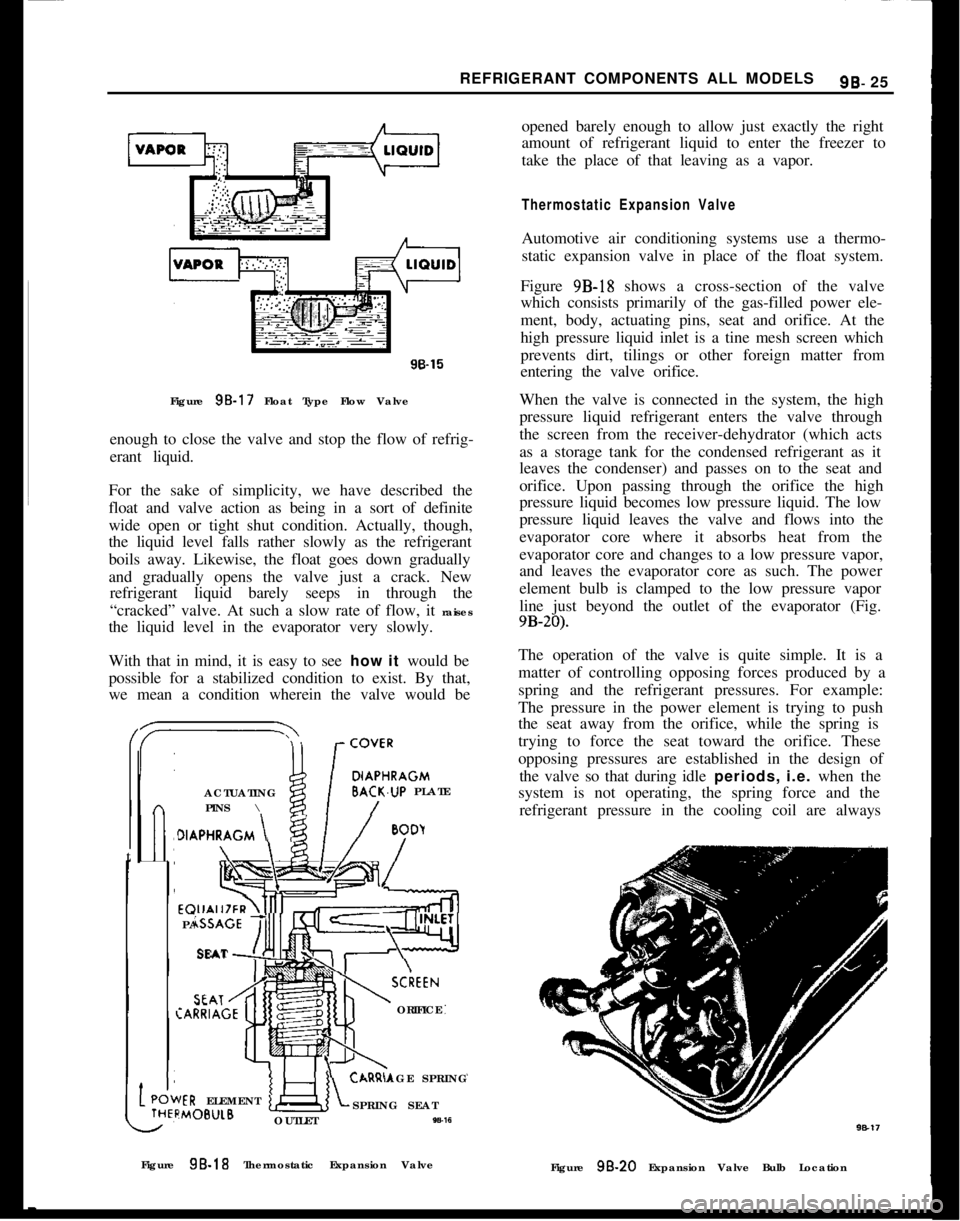
REFRIGERANT COMPONENTS ALL MODELS9B- 2596.15
Figure 95.17 Float Type Flow Valve
enough to close the valve and stop the flow of refrig-
erant liquid.
For the sake of simplicity, we have described the
float and valve action as being in a sort of definite
wide open or tight shut condition. Actually, though,
the liquid level falls rather slowly as the refrigerant
boils away. Likewise, the float goes down gradually
and gradually opens the valve just a crack. New
refrigerant liquid barely seeps in through the
“cracked” valve. At such a slow rate of flow, it raises
the liquid level in the evaporator very slowly.
With that in mind, it is easy to see how it would be
possible for a stabilized condition to exist. By that,
we mean a condition wherein the valve would be/
DIAPHRAGMACTUATINGBACK.UP PLATE
PINS \
t
>IAPHRAGM \
/
BoDyEQUALIZER\4]
PASSAGE
‘!!!ISEATSCkEEN:ARRIAGEORIFICE
AGE SPRINGIER ELEMENT:MOB”LBSPRING SEAT
OUTLET
W-16opened barely enough to allow just exactly the right
amount of refrigerant liquid to enter the freezer to
take the place of that leaving as a vapor.
Thermostatic Expansion ValveAutomotive air conditioning systems use a thermo-
static expansion valve in place of the float system.
Figure 9B-18 shows a cross-section of the valve
which consists primarily of the gas-filled power ele-
ment, body, actuating pins, seat and orifice. At the
high pressure liquid inlet is a tine mesh screen which
prevents dirt, tilings or other foreign matter from
entering the valve orifice.
When the valve is connected in the system, the high
pressure liquid refrigerant enters the valve through
the screen from the receiver-dehydrator (which acts
as a storage tank for the condensed refrigerant as it
leaves the condenser) and passes on to the seat and
orifice. Upon passing through the orifice the high
pressure liquid becomes low pressure liquid. The low
pressure liquid leaves the valve and flows into the
evaporator core where it absorbs heat from the
evaporator core and changes to a low pressure vapor,
and leaves the evaporator core as such. The power
element bulb is clamped to the low pressure vapor
line just beyond the outlet of the evaporator (Fig.
9B-20).The operation of the valve is quite simple. It is a
matter of controlling opposing forces produced by a
spring and the refrigerant pressures. For example:
The pressure in the power element is trying to push
the seat away from the orifice, while the spring is
trying to force the seat toward the orifice. These
opposing pressures are established in the design of
the valve so that during idle periods, i.e. when the
system is not operating, the spring force and the
refrigerant pressure in the cooling coil are always
Figure 9B-18 Thermostatic Expansion Valve
Figure
98.20 Expansion Valve Bulb Location
Page 535 of 625
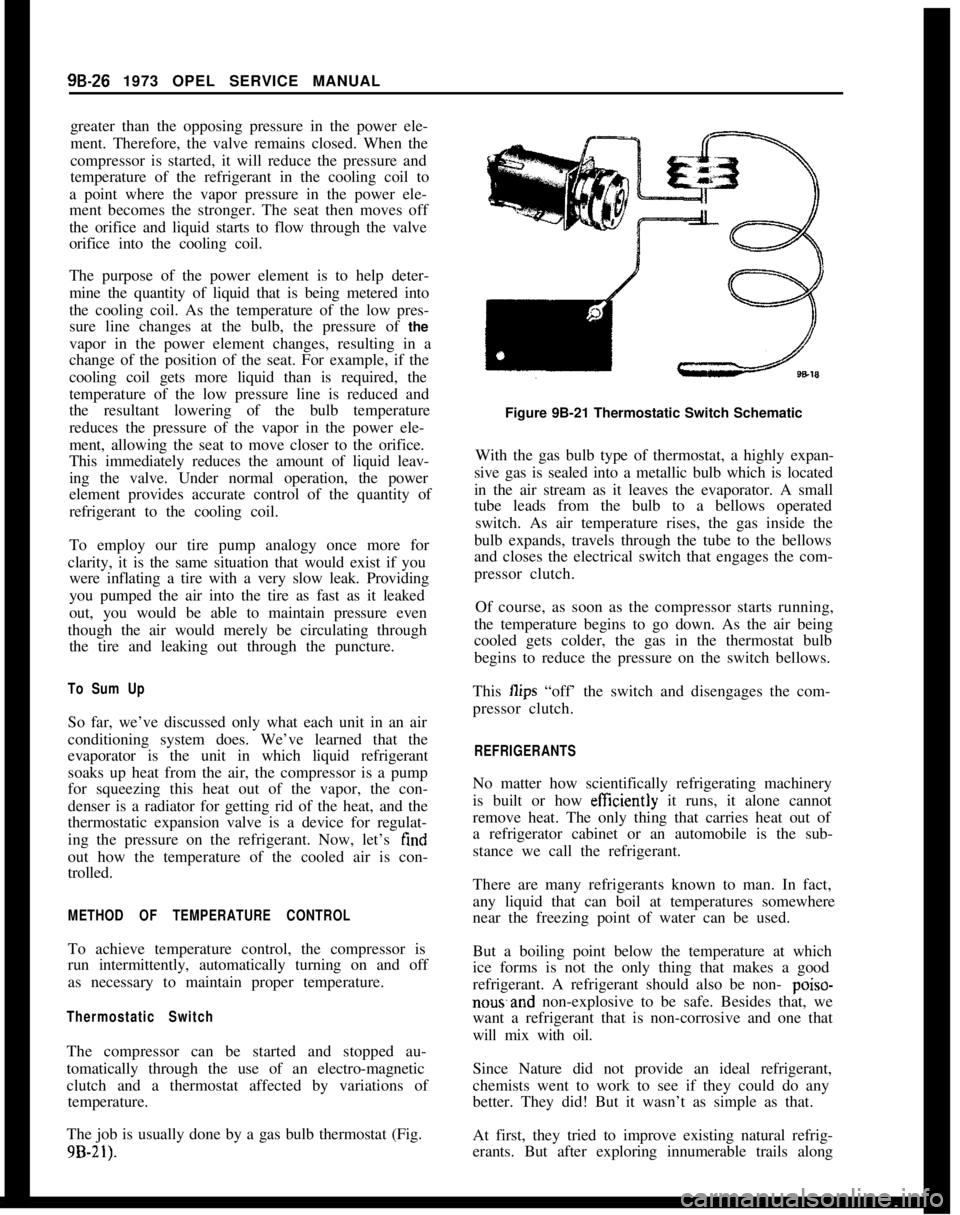
98-26 1973 OPEL SERVICE MANUAL
greater than the opposing pressure in the power ele-
ment. Therefore, the valve remains closed. When the
compressor is started, it will reduce the pressure and
temperature of the refrigerant in the cooling coil to
a point where the vapor pressure in the power ele-
ment becomes the stronger. The seat then moves off
the orifice and liquid starts to flow through the valve
orifice into the cooling coil.
The purpose of the power element is to help deter-
mine the quantity of liquid that is being metered into
the cooling coil. As the temperature of the low pres-
sure line changes at the bulb, the pressure of
the
vapor in the power element changes, resulting in a
change of the position of the seat. For example, if the
cooling coil gets more liquid than is required, the
temperature of the low pressure line is reduced and
the resultant lowering of the bulb temperature
reduces the pressure of the vapor in the power ele-
ment, allowing the seat to move closer to the orifice.
This immediately reduces the amount of liquid leav-
ing the valve. Under normal operation, the power
element provides accurate control of the quantity of
refrigerant to the cooling coil.
To employ our tire pump analogy once more for
clarity, it is the same situation that would exist if you were inflating a tire with a very slow leak. Providing
you pumped the air into the tire as fast as it leaked
out, you would be able to maintain pressure even
though the air would merely be circulating through the tire and leaking out through the puncture.
To Sum Up
So far, we’ve discussed only what each unit in an air
conditioning system does. We’ve learned that the
evaporator is the unit in which liquid refrigerant
soaks up heat from the air, the compressor is a pump
for squeezing this heat out of the vapor, the con-
denser is a radiator for getting rid of the heat, and the
thermostatic expansion valve is a device for regulat-
ing the pressure on the refrigerant. Now, let’s
find
out how the temperature of the cooled air is con-
trolled.
METHOD OF TEMPERATURE CONTROL
To achieve temperature control, the compressor is
run intermittently, automatically turning on and off
as necessary to maintain proper temperature.
Thermostatic Switch
The compressor can be started and stopped au-
tomatically through the use of an electro-magnetic
clutch and a thermostat affected by variations of temperature.
The job is usually done by a gas bulb thermostat (Fig.
9B-21).
Figure 9B-21 Thermostatic Switch Schematic
With the gas bulb type of thermostat, a highly expan-
sive gas is sealed into a metallic bulb which is located
in the air stream as it leaves the evaporator. A small
tube leads from the bulb to a bellows operated switch. As air temperature rises, the gas inside the
bulb expands, travels through the tube to the bellows
and closes the electrical switch that engages the com-
pressor clutch.
Of course, as soon as the compressor starts running,
the temperature begins to go down. As the air being
cooled gets colder, the gas in the thermostat bulb
begins to reduce the pressure on the switch bellows.
This
Ilips “off’ the switch and disengages the com-
pressor clutch.
REFRIGERANTS
No matter how scientifically refrigerating machinery
is built or how
efftciently it runs, it alone cannot
remove heat. The only thing that carries heat out of
a refrigerator cabinet or an automobile is the sub-
stance we call the refrigerant.
There are many refrigerants known to man. In fact,
any liquid that can boil at temperatures somewhere
near the freezing point of water can be used.
But a boiling point below the temperature at which
ice forms is not the only thing that makes a good
refrigerant. A refrigerant should also be non-
poiso-
nowand non-explosive to be safe. Besides that, we
want a refrigerant that is non-corrosive and one that
will mix with oil.
Since Nature did not provide an ideal refrigerant,
chemists went to work to see if they could do any
better. They did! But it wasn’t as simple as that.
At first, they tried to improve existing natural refrig-
erants. But after exploring innumerable trails along
Page 546 of 625
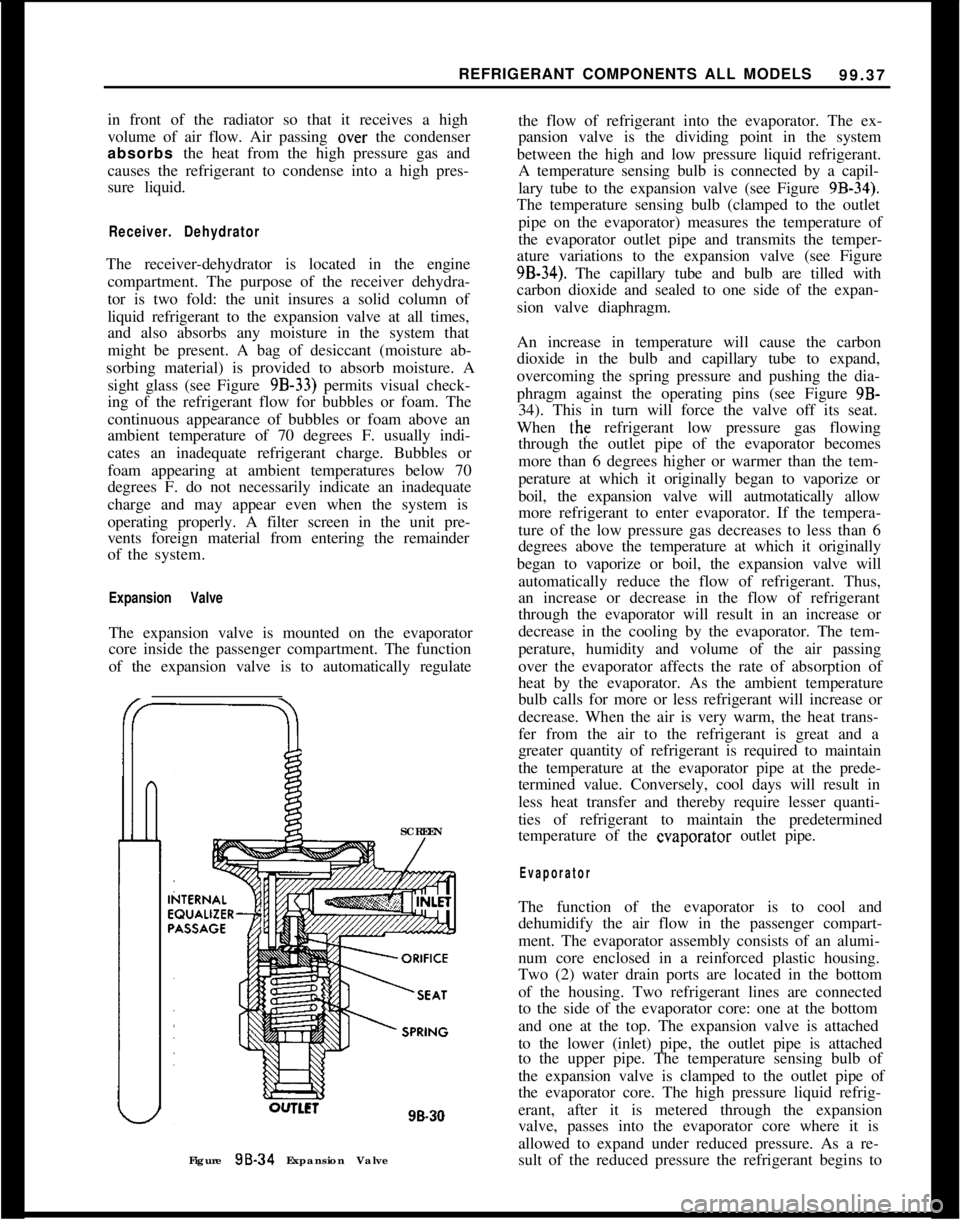
REFRIGERANT COMPONENTS ALL MODELS
99.37
in front of the radiator so that it receives a high
volume of air flow. Air passing over the condenser
absorbs the heat from the high pressure gas and
causes the refrigerant to condense into a high pres-
sure liquid.Receiver. DehydratorThe receiver-dehydrator is located in the engine
compartment. The purpose of the receiver dehydra-
tor is two fold: the unit insures a solid column of
liquid refrigerant to the expansion valve at all times,
and also absorbs any moisture in the system that
might be present. A bag of desiccant (moisture ab-
sorbing material) is provided to absorb moisture. A
sight glass (see Figure 9B-33) permits visual check-
ing of the refrigerant flow for bubbles or foam. The
continuous appearance of bubbles or foam above an
ambient temperature of 70 degrees F. usually indi-
cates an inadequate refrigerant charge. Bubbles or
foam appearing at ambient temperatures below 70
degrees F. do not necessarily indicate an inadequate
charge and may appear even when the system is
operating properly. A filter screen in the unit pre-
vents foreign material from entering the remainder
of the system.
Expansion ValveThe expansion valve is mounted on the evaporator
core inside the passenger compartment. The function
of the expansion valve is to automatically regulate
SCREEN
lLCl98.30
Figure 98-34 Expansion Valvethe flow of refrigerant into the evaporator. The ex-
pansion valve is the dividing point in the system
between the high and low pressure liquid refrigerant.
A temperature sensing bulb is connected by a capil-
lary tube to the expansion valve (see Figure
9B-34).The temperature sensing bulb (clamped to the outlet
pipe on the evaporator) measures the temperature of
the evaporator outlet pipe and transmits the temper-
ature variations to the expansion valve (see Figure
9B-34). The capillary tube and bulb are tilled with
carbon dioxide and sealed to one side of the expan-
sion valve diaphragm.
An increase in temperature will cause the carbon
dioxide in the bulb and capillary tube to expand,
overcoming the spring pressure and pushing the dia-
phragm against the operating pins (see Figure 9B-
34). This in turn will force the valve off its seat.
When the refrigerant low pressure gas flowing
through the outlet pipe of the evaporator becomes
more than 6 degrees higher or warmer than the tem-
perature at which it originally began to vaporize or
boil, the expansion valve will autmotatically allow
more refrigerant to enter evaporator. If the tempera-
ture of the low pressure gas decreases to less than 6
degrees above the temperature at which it originally
began to vaporize or boil, the expansion valve will
automatically reduce the flow of refrigerant. Thus,
an increase or decrease in the flow of refrigerant
through the evaporator will result in an increase or
decrease in the cooling by the evaporator. The tem-
perature, humidity and volume of the air passing
over the evaporator affects the rate of absorption of
heat by the evaporator. As the ambient temperature
bulb calls for more or less refrigerant will increase or
decrease. When the air is very warm, the heat trans-
fer from the air to the refrigerant is great and a
greater quantity of refrigerant is required to maintain
the temperature at the evaporator pipe at the prede-
termined value. Conversely, cool days will result in
less heat transfer and thereby require lesser quanti-
ties of refrigerant to maintain the predetermined
temperature of the evaporator outlet pipe.
EvaporatorThe function of the evaporator is to cool and
dehumidify the air flow in the passenger compart-
ment. The evaporator assembly consists of an alumi-
num core enclosed in a reinforced plastic housing.
Two (2) water drain ports are located in the bottom
of the housing. Two refrigerant lines are connected
to the side of the evaporator core: one at the bottom
and one at the top. The expansion valve is attached
to the lower (inlet) pipe, the outlet pipe is attached
to the upper pipe. The temperature sensing bulb of
the expansion valve is clamped to the outlet pipe of
the evaporator core. The high pressure liquid refrig-
erant, after it is metered through the expansion
valve, passes into the evaporator core where it is
allowed to expand under reduced pressure. As a re-
sult of the reduced pressure the refrigerant begins to
Page 549 of 625

98.40 1973 OPEL SERVICE MANUAL
2. Interconnect manifold and gage set (J-5725-01),
gage charging lines (J-5418) and gage adapters
(J-5420) to air conditioning system as shown in Figure
9B-40.3. Place transmission in “Park” for automatics and
in neutral for manuals. Apply hand brake.
4. Turn blower switch to the “Hi” position.
5. Turn temperature switch to “Max” position.
6. Run engine at 2000 RPM for ten (10) minutes with
car doors and windows closed and the hood up. Place
a high volume industrial type fan in front of radiator
if head pressure should exceed 250 psi and also at
high ambients to bring the pressures to within the
limits specified in the Functional Charts in Division
V.In the case of the Opel 1900 and the Manta, a ther-
mometer should be placed in a position to read the
temperature of the air discharging from the right-
hand A/C outlet. In case of the GT, a thermometer
should be placed in a position to read the tempera-
ture of the air discharging from the left-rear A/C
outlet.
HEATER-AIR CONDITIONER REFRIGERANT
CIRCUIT TROUBLE DIAGNOSIS GUIDE
Insufficient Cooling (Check Air Flow)
Normal Air Flow (Inspect system for visual defects.
Run functional tests.)
Discharge Air
- Normal Temp Check for air leaks
through dash, car body, windows, or from heater or
ventilators.
Discharge Air
- High Temp Check sight glass for
foaming and compressor clutch for engagement.
No Compressor Clutch Engagement Check connec-
tions at clutch switch, harness connectors, and check
clutch switch.
No Foaming Compare evaporator pressure to that
on functional test table.
Foaming System is probably low on refrigerant.
Check for leaks, repair, evacuate, and charge. If
foaming still occurs, check for restriction in refriger-
ant lines between condenser and receiver dehydrator.
Evaporator Pressure Normal Compare head pres-
sure to pressure on functional test table.
Evaporator Pressure Low Ice may be forming on
evaporator. Low volume of air discharging at A/C
outlet after system has been running above idle con-dition
,for approximately 15-30 min.utes. Discharging
air gradually elevating in temperature. Check expan-
sion valve. If valve isn’t permitting flow of liquid,
this will be indicated by a warm pipe out of the
evaporator. This may be caused by: 1) Clogged or
Plugged inlet screen in the expansion valve; 2)
Broken capillary line; or 3) Discharged temperature
bulb. If the valve is okay, the pipe out of the evapora-
tor will be cold.
Evaporator Pressure High Check the expansion
valve to determine if themobulb is making good con-
tact and is properly insulated. Operate engine at 2000
RPM with maximum air conditioning setting. If
evaporator pressure remains high, feel suction line.
If line feels frosty or extremely
(cold with relative
high ambient conditions, then partially cover the
condenser to obtain head pressures from 265 psi to
280 psi maximum. If evaporator pressure rises above
30 psi, change the expansion valve.
Also, check if compressor may be the cause due to
some internal or external mechanical trouble which
prevents reduction of pressure. Check for external
troubles, slipping belt, bad clutch and/or pulley, or
improper clutch engagement, before investigating
the compressor internally.
Head Pressure High Check for the following: Con-
denser air flow low, air in system, excessive refriger-
ant in system, restriction in condenser.Head.PressureLowRestriction in flow of refrigerant
to evaporator, or expansion valve plugged or defec-
tive.
Low Air Flow (Check blower operation and
evaporator. Check operation of controls.)
Ice BIocking Evaporator Run functional test. If
evaporator pressure is low, ice may form on evapora-
tor and reduce air flow.
Evaporator Pressure Low Ice may be forming on
evaporator. Low volume of air discharging at A/C
outlet after system has been running above idle con-
dition for approximately 15-30 minutes. Discharging
air gradually elevating in temperature. Check expan-
sion valve. If valve isn’t permitting flow of liquid,
this will be indicated by a warm pipe out of the
evaporator. This may be caused by: 1) Clogged or
plugged inlet screen in the expansion valve; 2)
Broken capillary line, or 3) Discharged temperature
bulb. If the valve is okay, the pipe out of the evapora-
tor will be cold.BlowerNot OperatingCheck for the following: Fuse
blown, blower switch defective, wire broken or loose
connection, poor ground connection, or blower mo-
tor defective.
Page 557 of 625

98-48 1973 OPEL SERVICE MANUALCondition3. Compressor being
replaced with a ser-vice replacement
compressor major
oil loss evident.
Amount of Oil Drained
From Compressora. More than 4 oz.Amount of 525 Oil to Install
In Compressor
a.
Same amount as drained from
compressor being replaced.4. Compressor being
rebuilt or repaired
-no major oil loss
evident.b. Less than 4 oz.
a. More than 1
l/2 oz.b. Install 6 oz.
a. Same amount a.s drained from
compressor, plus
1 oz. additional.
5. Compressor being
rebuilt or repaired
major loss of oil
evident.b. Less than 1
l/2 oz.
a. More than 4 oz.b. Install 7 oz.
a. Same amount as drained from
compressor, plus 1
ozadditional.If foreign material is noted in oil drained from sys-
tem or evidence of moisture is obvious in the compo-
nents removed, it is recommended that the entire
system be flushed and the receiver-dehydrator be
replaced. A full oil charge of 10 oz. of 525 viscosity
refrigeration oil should be replaced in the system. It
should be noted that all service replacement com-
pressors will be supplied with 10 pz. of oil. In most
cases it will be necessary to drain oil from service
replacement compressor and refill it with amount as
specified in the Oil Replacement Table.filter screen on the expansion valve should be re-
placed. If the evaporator assembly is flushed while
installed in the car, the temperature bulb on the
evaporator outlet pipe must be disconnected to keep
the expansion valve from closing at the inlet source.
FLUSHING THE SYSTEMIt is recommended that dry nitrogen be used as a
flushing agent due to the low cost involved. In addi-
tion, dry nitrogen will not cause a temperature drop,
as in the case of refrigerant-12, which results in
thickening of refrigerant oil. Dry nitrogen has the
additional advantage of removing moisture from thesystem.Flushing of the system may involve all the compo-
nents of the system or individual components in the
system. The components may be flushed while
mounted in the engine compartment or may be
removed for flushing. When a component is not
removed, disconnect all refrigerant lines or hoses
attached to component. To perform flushing operat-
ion, connect a cylinder of refrigerant-12 to the com-
ponent to be flushed, ,then invert the cylinder and
open the cylinder valve so that the liquid refrigerant
pours out and through the component. When liquid
Refrigerant-12 reaches atmospheric pressure, it im-
mediately drops to minus 21.7 degrees F. Insure that
area immediately surrounding outlet of component is
clear of anything that may be damaged by contact
because of the sudden drop in temperature.MAJOR REPAIR
REMOVAL AND INSTALLATION OF
COMPRESSOR
- OPEL 1900 - MANTA
Removal
I. Remove negative battery cable from battery.
2. Remove air cleaner and heat pipe. Cover the
carburetor to keep out dirt etc.
3. Discharge system. Refer to DISCHARGING
SYSTEM.
In all cases where a complete system flushing operat-4. While system is discharging remove sheet metal
ion is performed, the receiver-dehydrator and thecover. See Figure
9B-50.